- Bernard Preston homepage
- Citrus
- Mandarin Orange Tree
Mandarin orange tree
Mandarin orange tree is just as pretty as the lemon and ten-times as sweet.
The problem with much citrus is the pips and the hassle with
peeling; not so this sweet-fruit from China.
The Mandarin is seedless and easy to skin; more, it is very juicy and sweet. It's known in China as the honey-citrus.
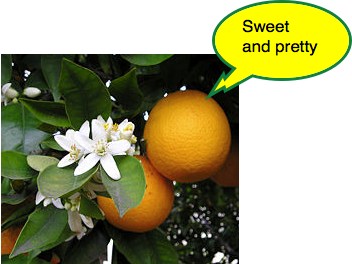
This page was updated on 5th May, 2023.
Watching our
two-year old grandchild sitting under the Satsuma this year,
working her way through one fruit after another, made me realise I had
better plant another; in fact, maybe three or four. I didn't get even to
sample a half.
It's known as a naartje in my homeland, from a Hindi word[3]; South Africa has the largest community of Indians outside the subcontinent. It is fairly frost-resistant, and hence it grows well at our 3500 feet above sea level.
Mandarin orange tree
Mandarin orange tree is full of vitamin C and bioflavonoids; all good anti-tumour stuff. In addition, citrus is the richest source of beta-cryptoxanthin; scientists have shown that consumed from food regularly it is a powerful tool in the prevention of age onset dementia.
What is an antioxidant good for is a commonly asked question; just about everything. The fruit from your Mandarin orange tree is full of them; they protect the cells of the body from free radical damage.
Because it doesn't travel well since it is easily bruised, the Mandarin is the perfect fruit to grow in your garden. Avoid buying them at the greengrocer; often you will be disappointed.
And like the Meyer lemon with its beautiful yellow fruit, the Satsuma as it is sometimes called makes a marvelous small decorative tree; with the added advantage that the flavour of the Honey-Orange is to die for. Like most food that which is ripened on the plant, picked and taken straight to the kitchen is so much tastier and more nutritious.
Or simply sit under the tree like my granddaughter does and guzzle; granny discovered these garden fruits have been the solution to the stubborn constipation the wee lass was suffering from when we returned from our sojourn in Holland.
If you are interested you can get Stones in my Clog at the bottom of the page; it is dirt cheap and a wonderful book, so my friends tell me.
Two other varieties of mandarin orange trees are the Clementine and the Tangerine. All are fantastic with small differences to suit your palate.
Purchasing your mandarin orange tree from a recognised garden-shop is important.
Look for a young tree probably about 80cm high, roughly three-foot that is obviously strong and vigorous. In particular make sure there are no curling leaves that are turning yellow. Ask how long it has been in the shop. Is the soil moist?
And now you have to break your back if you want a decent mandarin orange tree that will bear fruit for years. Perhaps call upon your son in law but not if he's a desk-bound lawyer or accountant. Digging the pit is not for sissies; it is hard work.
It's beats going to the gym though; you will have something to show for your labours at the end of the day and your biceps will bulge just as impressively.
Do not delay; in fact it's best first to dig the pit for your Mandarin orange tree before you buy it. Make it square, the larger the better but at least a three-foot side; and as deep as you can manage.
A spade deep, about 3 foot, is considered perfect but moving a cubic-metre of earth will keep you busy. I know, I did it today and am feeling distinctly weary though not in pain. The body glories in exercise. It is the couch that is the potato's downfall.
Always before tackling a heavy task like gardening, just lie on the grass and do these simple lower back exercises; they take only one minute. It might save you a couple visits to the DC. I'm in luck for I have a resident doctor, my daughter should things go wrong, which they do of course occasionally. I am a patient too.
Copy and paste "lower back exercises" into Site Search in the main menu for more information.
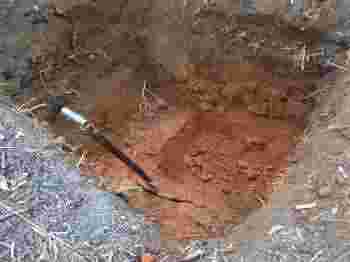
Fill your crater with as much coarse garden material as you can find. Straw, sticks and even a couple of small rotting logs are all perfect; and then with at least 6" of compost.
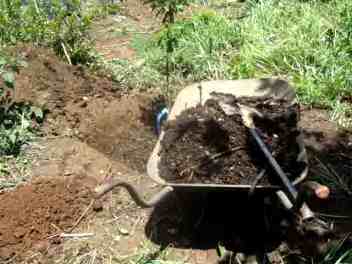
Starting a compost pile is fundamental to the organic-garden.
Shovel the top-layer back into your hole, leaving the subsoil aside. You can either add it to the above, or use it to cover your compost pile. Better still, just spread it around between the trees in your orchard.
You want the bed to be about 4 to 6 inches above ground level; it'll subside. Now peel the bag off your mandarin orange tree, being careful to keep the roots intact; actually just shred it, as it is not worth reusing because of any disease or pests. Place the bowl of your little plant into the pit you have dug, so that the soil will be the same height as in the garden.
If you're not an organic fanatic, this is the time to spread a little general-fertilizer around your mandarin orange tree; keep it well away from the trunk.
Newsletter
Our newsletter is entitled "create a cyan zone" at your home, preserving both yourself and Mother Earth for future generations; and the family too, of course. We promise not to spam you with daily emails promoting various products. You may get an occasional nudge to buy one of my books.
Here are the back issues.
- Lifestyle and ideal body weight
- What are ultra-processed foods?
- Investing in long-term health
- Diseases from plastic exposure
- Intensive lifestyle management for obesity has limited value
- A world largely devoid of Parkinson's Disease
- The impact of friendly bacteria in the tum on the prevention of cancer
- There's a hole in the bucket
- Everyone is talking about weight loss drugs
- Pull the sweet tooth
- If you suffer from heartburn plant a susu
- Refined maize meal and stunting
- Should agriculture and industry get priority for water and electricity?
- Nature is calling
- Mill your own flour
- Bake your own sourdough bread
- Microplastics from our water
- Alternative types of water storage
- Wear your clothes out
- Comfort foods
- Create a bee-friendly environment
- Go to bed slightly hungry
- Keep bees
- Blue zone folk are religious
- Reduce plastic waste
- Family is important
- What can go in compost?
- Grow broad beans for longevity
- Harvest and store sunshine
- Blue zone exercise
- Harvest and store your rainwater
- Create a cyan zone at your home
If you have a prolific compost heap then add a few more shovels.
For the tiny backyard this compact tumbler may suit and if you have a vast old garden like mine, then logs and sticks make perfect humus; but you will have to wait longer for well-rotted compost of course.

Composting from old sticks and logs and a Compact Compost Tumbler both make excellent humus.
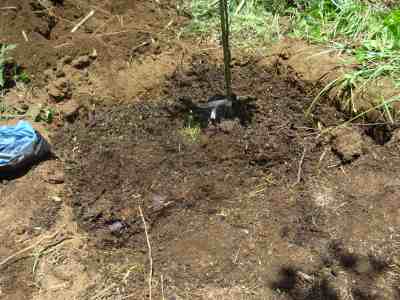
The rough compost from old logs and sticks is perfect for the deep holes you'll need to dig for trees.
Notice my mandarin orange tree's shadow. Mad dogs and South Africans go out in the midday-sun; with a hat on.
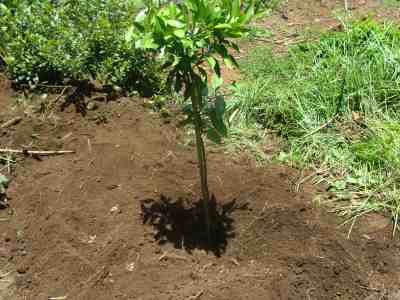
Shape a small hollow for the water you may need for irrigation in dry periods.
Start by some deep irrigation of your new mandarin orange tree.
Now all you and I need is a little patience. Pick off any flowers in the first-season so the energy goes into the tree.
Two years later
Two-years later this is what our young mandarin orange fruit tree looks like. I've just picked the last fruit for our breakfast; it is going to be a long wait to next season.
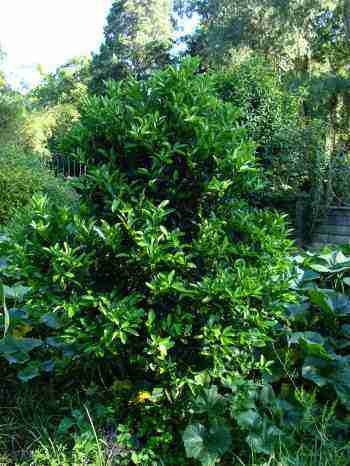
We now provide liquid manure from our worm farm for the fruit trees and the vegetables; they speed up the process.
A worm farm requires very little attention; just the vegetable refuse from your kitchen. Today the creepy crawlies got a rotten butternut and they love fruit such as fallen plums; in fact they will demolish almost any food that is past its sell-by date, unless it is highly refined. They won't touch pizza dough for example.
The wonder of worm farms has brought a whole different slant to our garden; they are everywhere now, and the hens love scratching for them too.
Mandarin first fruits
Savour the mandarin first-fruits but soon there'll be hundreds.

The profusion of fruit
Our very old mandarin orange fruit tree that we planted nearly three decades ago started to go into decline last year, overtaken and shadowed by a large azalea-bush. Since we have many of the latter, it came out. Just look at the profusion since giving it more light.
In addition the two new trees are starting to bear so it's like Christmas.
I find it interesting they start to bear just before winter when we need vitamin C most to fight off colds and flu.
Likely you too have troubles with sap-sucking pests. This white oil manufacturers mix is so easy to make yourself.
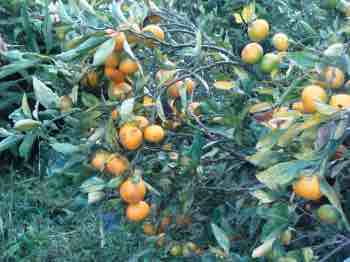
If you use worm-wee to fertilise your mandarin orange tree, then expect to thin the fruit, otherwise you'll have branches breaking.
What is a worm farm is a question you may be asking; a small factory that produces vermi-leachate that will make any plant flower profusely.
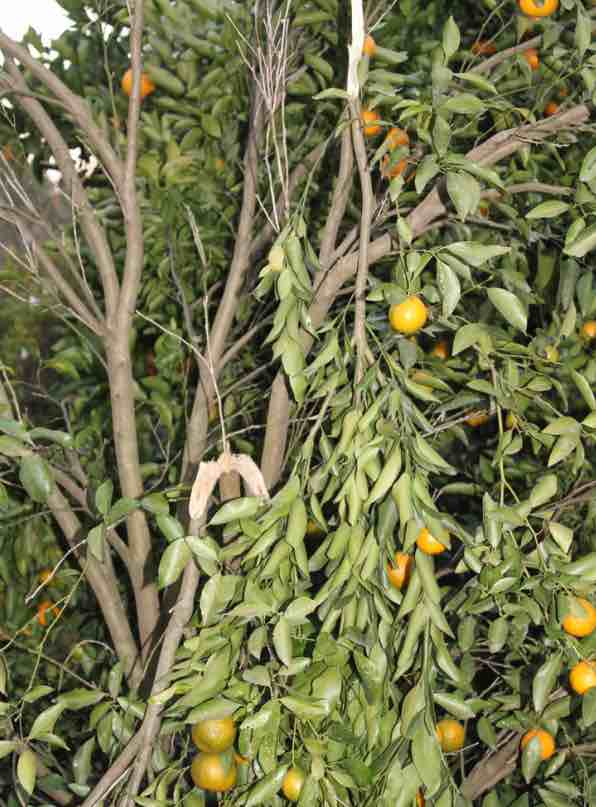
There are far too many to eat, so we squeeze them. Notice the reamer has no strainer; enjoy the pulp as well. That's where half the nutrients are found. In season they are an important part of our "viral guard;" a mixed drink from our citrus fruit list.
Vitamin C
Vitamin C is an absolutely vital part of the growth and wellness of normal-tissues. Have you heard of scurvy? Even your gums require adequate levels; mandarin orange trees and of course lemons and limes too are part of the solution.
Tissues cannot heal without a regular supply of vitamin-C. Because it's water soluble you have to consume it daily. Get it from your food, not from a pill.
Citrus and the pepper family are the two richest sources. Plant a few sweet paprikas and a couple jalapenos in your front garden; they are so pretty when they change to their deep colours, loaded with life-giving phytosterols and vitamin C.
I love to make this green chili sauce recipe through the summer and especially when the citrus is nearly over for our vitamin-C.
Just look at this prolific fruit from one of our mandarin orange trees; we have two.
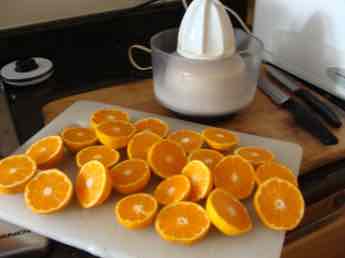
What are phytosterols?
What are phytosterols is a fundamentally important question; in days of yore when we ate plenty of unprocessed food you did not need to understand it. Now life is quite different; tumours and painful-joints are thriving because we do not pay attention. Your mandarin orange tree is loaded with these powerful nutrients.
One of them is called beta-cryptoxanthin; it has the proven ability to prevent age related dementia. No one wants to lose their marbles; enjoy citrus daily.
It's interesting that farmers are adding phytosterols, including citrus peel to chicken and pig food. They are finding that the animals are stronger; and perhaps more importantly from their point of view is that the conversion rate, the overall gain-feed ratio improves. They grow faster.
What's good for chickens and pigs is surely good for humans too. Eat more phytosterols in basically all fruit and veg and especially citrus.
You are not still on a Black and White diet I hope. That went out with B&W TV; turn to colour.
Copy and paste "what are phytosterols" into Site Search in the main menu for more information.
Lemon tree, very pretty
There was a time when every teenager was humming lemon-tree, very pretty.
Now think about growing lemon trees.
Our grand-kids, not unlike most I suspect, are not crazy about their greens; but today you should have seen them asking for more of our bean salad. Lightly steamed, and then plunged hot into a mixture of olive oil, lemon juice and finely chopped garlic. We have it almost daily through the summer season.
Freezing lemon juice makes it available year-round.
Growing and cooking green beans is high on our agenda; we are flexitarian, trying to get more of our protein from legumes. It is good for us and the planet; we are trying to build a small Cyan Zone at our home where both we and Mother Earth will flourish.
Bioflavonoids
Citrus is not just about vitamin C; as important are the little-known bioflavonoids. These are the vital substances that give fruit and veg their vibrant colours; they are known as "functional foods" because they both prevent disease and promote wellness.
Read more about orange juice bioflavonoids; for the record, they are much less in OJ from a carton. You have to eat whole oranges, or squeeze your own to get the pulp; the fresher the better. Where possible grow your own mandarin orange trees, lemons and limes.
Just one is the B-vitamin choline; the average Western food has less than half the recommended daily amount. It is vitally important in preventing birth defects like spina bifida and boosting the brain of the growing child.
One tidbit of interest; the offspring of pregnant-rats never get senile dementia if their mothers were fed large amounts of choline during the pregnancy.
Choline food sources is an important subject for every one of us; it's a large part of the reason why we've started rearing hens for free range eggs.
There's a wonderful synergy of green living, I've discovered quite by accident. For example, we start keeping pasture fed hens for their choline-rich eggs, and for the first time in several years we can grow green beans again; they've devoured the Mexican bean beetle larvae that overwinters in the soil and under the mulch. The infestation was so bad, and I refuse to spray with toxic pesticides, that we had to stop growing one of our favourite and important vegetables.
Blood glucose
One last thought about your mandarin orange tree; what effect will the fruit have on your blood glucose? We live in a world that is becoming more insulin resistant by the day, not because of enjoying whole citrus, but refined carbohydrate like that in OJ from a carton. It's fattening junk-food.
I'm prediabetic myself. Orange juice taken as a snack causes my blood glucose to soar; that means inflammation and pain. There are two options; take a short ten-minute stroll after your drink, or have it in the context of a whole meal.
Take this seriously, especially if you are significantly overweight; then you need to limit even the good the starch from your food, and eliminate all refined carbohydrate. We do it anyway.
Weight loss research now fingers refined carbs and not fat as the chief cause of obesity.
Spinal manipulation
A DC can adjust and set your joints in motion, but only good nutrition, which must include vitamin-C can provide the elements required for healing of cartilage; a mandarin orange tree is part of that process.
Vitamin C is one of the four[1] that prevent frailty syndrome; well, you do need to walk or swim regularly too.
Why all this about citrus on this website you may be thinking; regularly we are faced with folk who ache all over. They have plantar myofasciitis, an aching hip, and midback pain; and a sore shoulder and so on. Generalised anger in the body is caused amongst other things by a lack of the anti-inflammatory substances that we should be enjoying every day from our food. This mandarin orange tree is loaded with them.
Good for you, and it is bad for the doctor, right? Actually his chronic patients do not help him either. Those with these generalised aches from poor food one can never cure; they never refer you their friends and neighbours and their painful backs that keep recurring drain one's energy.
Interesting new research shows that both nerve-tissue and tendons are highly sensitive to raised blood glucose; getting onto food that is very low in glycemic carbohydrate is important. Avoid OJ from a carton; no question of it, it is bad for you. And take a short walk after a starchy meal.
Useful links
When browsing use right click and "Open Link in New Tab" or you may get a bad gateway signal.
- TREE PLANTING HELP ...
- Butternut squash soup recipe for more bioflavonoids.
Bernard Preston
Bernard Preston is a semi-retired DC with an intense interest in natural living and choice foods straight from the garden; he has three mandarin orange trees. The reddish colour means it's significantly richer in an important vitamin called betaine.
Freshness is everything; once air gets into your nosh, oxidation begins and its value is reduced. Luckily many foods, like pecan-nuts and the fruit of the mandarin orange tree come wrapped in a protective layer against the atmosphere.
Lettuce though has no such protection and where possible you should grow it yourself. Just a few plants tucked in amongst the flowers with provide fresh leaves for many weeks if you nourish and water them.
Did you find this page interesting? How about forwarding it to a friendly book or food junkie? Better still, a social media tick would help.
- Bernard Preston homepage
- Citrus
- Mandarin Orange Tree
Address:
56 Groenekloof Rd,
Hilton, KZN
South Africa
Website:
https://www.bernard-preston.com